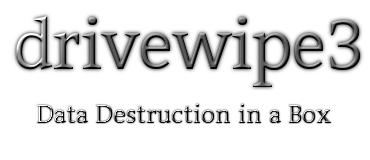
Description
Drivewipe3 uses client-server technology to network boot systems to be wiped on a dedicated and isolated network (do not connect the second NIC to a shared network!). It wipes the drives using any of five different wiping methods and stores the results, the wipe method, date/time of wipe, key system and drive details, and technician name in a central database. It is managed via a simple web-based interface, and supports multiple profiles which may be altered at wipe-time by the technician at the system being wiped. System may be set up for unattended wiping to wipe dozens/hundreds of systems simultaneously.
Web Interface
The web interface allows complete management of the Drivewipe3 system. It provides a dashboard to monitor the system's current state; provides an interactive search feature to look up system or drive serial numbers, exports wipes to Excel (CSV), allows importing/exporting databases to other Drivewipe3 systems; backs up the databases to an external file server (NFS or CIFS) as well as backing up and restoring from web browser. The Admin interface allows the technician to edit wipe profiles as well as reboot or shutdown the server.
Wipe Methods
There are five wipes supported by Drivewipe3:
1. Secure Erase with one-pass fallback. This wipe uses the ATA Secure Erase built into every ATA drive. Unlike other products, this wipe is 100% automatic, unfreezing the ATA drive and then issuing Secure Erase commands. If the Secure Erase fails, it will automatically fail over to the one-pass (below).
2. One-pass Zero. This wipe lays down binary zeroes in a single pass as described by NIST SP800-88r1.
3. One-pass Random. This wipe lays down random binary data in a single pass.
4. Two-pass Ones and Zeros. This wipe lays down random binary data in a single pass, followed by a pass of zeros, for a total of two passes. This wipe exercises the magnetic domains making data recovery more difficult.
5. DoD 3-Pass 5520.22-M. This wipe lays down a patterns of binary zeroes, followed by binary ones, followed by a random pattern. This three pass wipe makes data recovery from analyzing magnetic splashing even more difficult.
Minimum Requirements
Intel Core 2 Duo or better, 4GB RAM, 250GB Hard Disk, 2 Ethernet ports, Internet connection.
